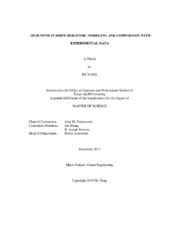| dc.contributor.advisor | Niedzwecki, John M | |
| dc.creator | Yang, He | |
| dc.date.accessioned | 2016-05-04T13:23:16Z | |
| dc.date.available | 2019-12-01T06:33:40Z | |
| dc.date.created | 2015-12 | |
| dc.date.issued | 2015-12-02 | |
| dc.date.submitted | December 2015 | |
| dc.identifier.uri | https://hdl.handle.net/1969.1/156507 | |
| dc.description.abstract | The potential for the development of offshore wind farms for deep water has inspired new designs of floaters that could survive harsher environments. Among all of the proposed designs, spar-type wind turbine appears to be a viable concept. The research work presented in this thesis utilizes two types of hydrodynamic numerical models to simulate the global motion response behavior.
The first model developed in this study provides global response information of a spar-type floater in both frequency and time domains. It located the body-coordinate at the net mass center, including structural mass and hydrodynamic added mass. The platform behavior was evaluated from both linear and non-linear forms of Morison’s Equation. The second model utilized industry standard software for response analysis. It coupled OrcaFlex software with mean-drift and full QTFs computed by WAMIT software. It provided fully nonlinear hydrodynamic simulation of the spar-type wind turbine and allowed the assessment of the wind effect on the whole floating system.
A model test was recently conducted in the State Key Lab of Ocean Engineering at Shanghai Jiao Tong University. It involved the study of NREL (National Renewable Energy Lab) 5MW baseline wind turbine atop the OC3-Hywind spar-buoy, working in a water depth of 200m. The global motions predicted using the numerical models were compared with the experimental measurements. The first model worked well for the wave-frequency range while the second model worked well for the whole frequency range which is needed for floating wind turbine simulations. It was observed that effect of the wind influenced the damping of the long period drifting motion, while the forced motion in wave-frequency range was not significantly influenced. | en |
| dc.format.mimetype | application/pdf | |
| dc.language.iso | en | |
| dc.subject | Spar Wind Turbine | en |
| dc.subject | Numerical Models | en |
| dc.subject | Experimental Comparison | en |
| dc.title | Spar Wind Turbine Behavior: Modeling and Comparison with Experimental Data | en |
| dc.type | Thesis | en |
| thesis.degree.department | Civil Engineering | en |
| thesis.degree.discipline | Ocean Engineering | en |
| thesis.degree.grantor | Texas A & M University | en |
| thesis.degree.name | Master of Science | en |
| thesis.degree.level | Masters | en |
| dc.contributor.committeeMember | Zhang, Jun | |
| dc.contributor.committeeMember | Newton, H. Joseph | |
| dc.type.material | text | en |
| dc.date.updated | 2016-05-04T13:23:16Z | |
| local.embargo.terms | 2019-12-01 | |
| local.etdauthor.orcid | 0000-0002-8905-5424 | |


